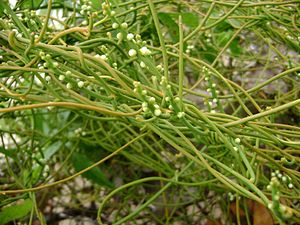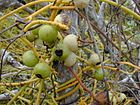Note: This is a project under development. The articles on this wiki are just being initiated and broadly incomplete. You can Help creating new pages.
Cassytha filiformis - Akashavalli
Revision as of 14:51, 15 April 2019 by Arun93 (talk | contribs) (Created page with "thumb|right|''Akashavalli'', ''Cassytha filiformmis'' '''Akashavalli''is leafless parasitic climbing twiner, that can be seen growing i...")
'Akashavalliis leafless parasitic climbing twiner, that can be seen growing in South India in very dry gravelly localities.
Contents
- 1 Uses
- 2 Parts Used
- 3 Chemical Composition
- 4 Common names
- 5 Properties
- 6 Habit
- 7 Identification
- 8 List of Ayurvedic medicine in which the herb is used
- 9 Where to get the saplings
- 10 Mode of Propagation
- 11 How to plant/cultivate
- 12 Commonly seen growing in areas
- 13 Photo Gallery
- 14 References
- 15 External Links
Uses
Dysentery, Skin diseases, Hair tonic, Dairrhea [1]
Parts Used
Chemical Composition
Common names
| Language | Common name |
|---|---|
| Kannada | aakasha balli, janivaara balli, |
| Hindi | Amarbeli |
| Malayalam | manjadiacatsjavalli, aiyapala, akashavalli |
| Tamil | amaravalli, ammaiyarkoonthal, |
| Telugu | ntharavallithige, nooluthige, nulutega, paachithige, seethammaavaari jadaalu, seethammapogunoolu, |
| Marathi | NA |
| Gujarathi | NA |
| Punjabi | NA |
| Kashmiri | NA |
| Sanskrit | Akashavalli, Amrtavalli, khavalli |
| English | Love vine |
Properties
Reference: Dravya - Substance, Rasa - Taste, Guna - Qualities, Veerya - Potency, Vipaka - Post-digesion effect, Karma - Pharmacological activity, Prabhava - Therepeutics.
Dravya
Rasa
Guna
Veerya
Vipaka
Karma
Prabhava
Habit
Identification
Leaf
| Kind | Shape | Feature |
|---|---|---|
Flower
| Type | Size | Color and composition | Stamen | More information |
|---|---|---|---|---|
| Bisexual | Spikes terminal or axillary; peduncle 2-4.5 cm; bracteoles 3, ovate, 1.2 mm, ciliate. Flowers sub sessile, in spikes, 3-merous, bisexual, 3 mm across. Tepals 6, free, unequal, 3+3, truncate, obtuse; outer lobes ovate-orbicular, 1.2 mm, ciliate; inner lobes obovate, 2.5 mm. Fertile stamens 9; filaments 1.5 mm; glands sessile; anthers 2-celled, 1.5 mm; staminodes 3, to 1 mm. Ovary 1.5 mm; style 0.5mm; stigma capitate. | {{{3}}} | {{{4}}} | {{{5}}} |
Fruit
| Type | Size | Mass | Appearance | Seeds | More information |
|---|---|---|---|---|---|
| A drupe | Drupe globose, enclosed within inflated perianth, crowned by lobes; seed 1. | {{{6}}} |
Other features
List of Ayurvedic medicine in which the herb is used
Where to get the saplings
Mode of Propagation
How to plant/cultivate
Season to grow
Soil type
Propagation
Commonly seen growing in areas
Photo Gallery
References
Cite error: <ref> tag with name "Leaf" defined in <references> is not used in prior text.
External Links
http://www.imedpub.com/articles/pharmacological-activities-of-cassytha-filiformis-a-review.pdf
Categories:
- Pages with reference errors
- Ayurvedic Herbs known to be helpful to treat Dysentery
- Ayurvedic Herbs known to be helpful to treat Skin diseases
- Ayurvedic Herbs known to be helpful to treat Hair tonic
- Ayurvedic Herbs known to be helpful to treat Dairrhea
- Herbs with Stem used in medicine
- Herbs with common name in Kannada
- Herbs with common name in Hindi
- Herbs with common name in Malayalam
- Herbs with common name in Tamil
- Herbs with common name in Telugu
- Herbs with common name in Sanskrit
- Herbs with common name in English
- Habit - Climber
- Herbs that are commonly seen in the region of Tropical area
- Herbs
- Deccan




